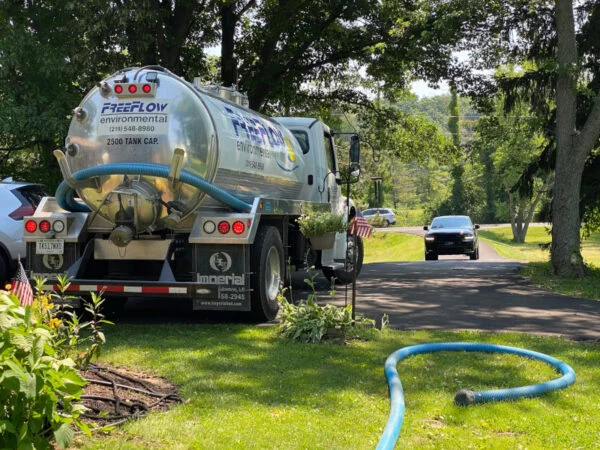We have all heard the stories about septic systems that have not been pumped in decades. On the other hand, most of us have seen the heavy construction machinery move into a neighborhood near us as a failing/broken septic system is replaced.
Clearly these represent the two extremes. The only systems that most homeowners care about fall squarely within the two lines of “average” because, let’s face it, they’re average.

In terms of averages:
- Septic tank size – 1000 Gallons.
- Both Regulatory Groups and the Pumping Industry agree that when 30% (300 Gallons) of that 1000 Gallons is comprised of waste-stream-solids, the tank should be pumped.
- It takes a family of 4 about 2 – 3 years to generate the 300 Gallons of solids or scum (oils, fats, greases which float) and sludge (partially decomposed organic matter which settles).
- If you’re obsessive, you could take this a step further. Determine the internal height of the tank with the help of a long pole or depth measuring device. When the sum thickness of the scum floating on top and the sludge that has settled on the bottom exceed 30% of the internal tank height – you should pump the tank.
- Opinion: When deciding on exactly when a tank should be pumped, consider the relatively inexpensive resultant charge, about $200.00, for having a 1000-gallon septic tank pumped. Then compare that low number to the relatively high expense of field replacement which in some cases can exceed $40,000.00. You might view pumping as cheap insurance.
Conclusion:
You are the manager (look around, there’s nobody else with you) of a privately-owned waste-water treatment plant. A good manager will keep operating costs low. A poor manager will allow operating costs to escalate. The experts say the prudent approach is; Family of 4 – Every 3 Years.
What Will Happen to Me if I Don’t Listen to Reason?
Let’s be honest. You’ve always chafed under the heavy hand of regimentation. You, my naive friend, are a Septic Rebel. If you don ‘teat your greens, the patient will get sick.
The Septic System Bad News
On average, the Simple Reason a previously functioning Septic System Fails or ceases to function as it was originally designed is simple. The wastewater being generated by the house now has nowhere to go.
In a bit more complex version … the Drainage Bed, (or the space where the water seeps into the surrounding soil) can no longer operate at the same level and treat the same volume that the original design called for.
This is most commonly ca used by an accumulation of organic matter within the voids of the stone and/or surrounding soil. This matter steals oxygen from the waste stream and slows the performance of the naturally occurring aerobic bacteria (naturally present in the top 18″ of most soils) which keep the normal accumulation of the sludge in check. At some point (usually due to system abuse or simply time) these bacteria become overwhelmed and the system starts to slow down in terms of the volume of liquid it can process.
It’s at this point where suggestions of heavy machinery, County Permitting Process, potential multi-month construction schedule, and “How are we going to pay for this?”, questions arise.
The Septic System Good News
The Good News is that, on average, the key components of the system are usually intact. This means – structurally sound and fully capable of performing as they were originally designed to do IF, you can create the proper environment.
More good news … the basic design elements that were present when the original field was designed probably have not changed. The Army Corp of Engineers probably has not made dramatic changes to the drainage plan in that part of the world. The ground water table levels probably have not been impacted by any local changes. And assuming the current system use does not deviate from the permitted use – a “failed” system can often be broke back to life in as little as 1 day, as opposed to months for a new system.
How Can You re-establish proper flow within the septic system?
It is surprising how often the only thing standing between the homeowner and a properly operating septic system is that accumulation of organic matter that we spoke of earlier. It accumulates within the tank, within the D-Box, inside the transmission lines, inside the drain bed lines themselves, and often within the stone that comprises the Drainage Bed. Removing this material and re-establishing the flow of oxygen within the space surrounding and including the drainage bed is the answer to the question.
Hopefully, we’ve helped clear up some questions!
If you are ready to schedule a septic pumping or field restoration assessment, visit our contact page here to send us a message or give us a call.
